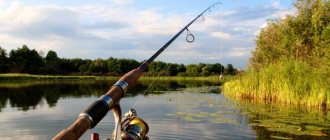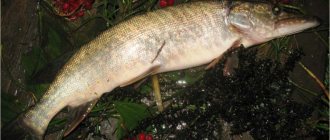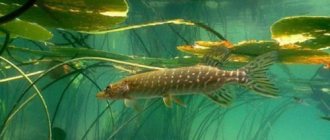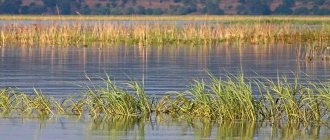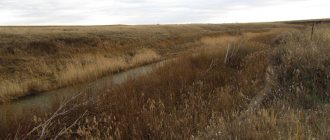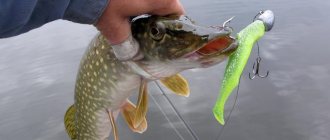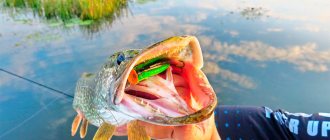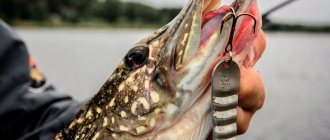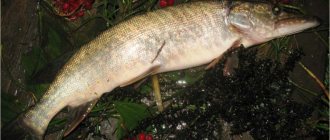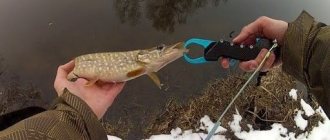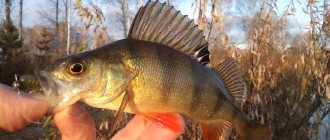With the onset of autumn, the fish finally comes to its senses after the long, sweltering summer heat and heat, and begins to gradually accumulate fat in anticipation of the onset of cold weather. Due to the sharp increase in appetite, the term fattening fish appeared.
And pike is no exception to this rule. As the mercury column of the thermometer gradually decreases, the longest period of autumn feeding begins for the toothed predator, which is well caught both with spinners and with silicone and various wobblers.
Pike fishing in autumn
As the air temperature drops to +20 - +23 degrees, the fishing for toothed predators begins. As for the time frame, in our area this is the period from late August to early September.
Schematically, experienced fishermen divide autumn into 2 parts, namely:
- until the algae die off
- after the algae die off.
It should be noted that pike quickly changes its tastes and food preferences in this relatively short period of time. Based on this, spinning anglers have an excellent opportunity to test different types of baits and fishing techniques.
Using wobblers for pike in autumn
What models of wobblers are best to use? Until the aquatic vegetation has grown to a size that greatly interferes with the normal fishing of the bait, it is advisable to have in your arsenal 2-3 twitching wobblers of the “minou” class, 10-15 cm long, characterized by a slight depth.
First of all, such conditions are a consequence of the existing need to fish “windows” - small areas of water more or less free from algae.
After the subsidence process begins, experienced fishermen advise scanning the shallow bays, which were inaccessible throughout the summer due to the continuous green carpet of vegetation.
Crank for pike
Next, you should definitely have several cranks with a depth that will be slightly less than the depth of the reservoir - we are talking about fats, shads, etc.
They are ideal for active use in deeper areas of reservoirs. You shouldn’t go too small with the sizes – it’s best to take baits from 8 cm and above.
The most optimal average size for pike is 12 cm. It should be noted that cranks may not be needed at all for effective fishing. This is a voluntary decision that directly depends on your preferences and the amount of money available. The fact is that fishing near the bottom of a reservoir invariably involves constant hooks, most of which end in dead hooks with the detachment of the bait used.
Spinner for pike
Many fishermen, based on their experience, believe that a spinning spoon is a mandatory component of the box of any self-respecting fan of spinning. is something of a fishing classic.
Aglia long specimens No. 2 and No. 3 are often used. They can be used until the beginning of October. For fishing in late autumn, it is best to use large, heavy pike spoons.
Spinner baits of this type are characterized by a “heavy” stroke, which skillfully imitates heavy prey, creating powerful acoustic waves. Just what you need for pike fishing in the fall.
November
Fishing in November with a spinning rod is often problematic - frosts occur in the mornings and the rings in the spinning rod freeze. It is necessary to spray them with silicone lubricant to make fishing possible. And at the end of November, sometimes reservoirs are completely covered with ice, so fishing with spinning rods ends at this time in late autumn.
Spinning fishing in November is unpredictable. It would seem that there are fish in wintering pits - take them and comb them with a jig. However, it doesn’t work out; the predator doesn’t take the bait. You have to try everything - edible silicone, jig spinners, spoons and deep wobblers.
In the complete absence of a bite, it is advisable to use tackle with a dead fish.
The main objects of spinning fishing in November are pike and perch. Moreover, you can look for them near holes, on edges and in river inlets. There are cases when at the beginning of winter the river was not yet covered with ice, and during this period a good feeding of pike was observed in the shallow inlet.
Silicone lures for pike fishing
This class of bait is a must-have for both experienced and novice spinning anglers. And this has nothing to do with their ability to provide a solid catch.
Silicone fish are always used in reservoirs where the depth does not allow timely monitoring of the presence of roots, underwater snags and other debris. They are also very effective in turbid water conditions. And even if they break, the loss will not hit your pocket hard, which cannot be said about most good spinners and wobblers.
If you live in Minsk, you can buy wobblers here
In the case of a standard installation on a jig head with a regular hook, quite often the fish can break off. In the case of fishing in the autumn, when using fish of 15 cm, a single strike with a tear off of the tail of a soft bait, or even a complete loss of prey, often happens.
To avoid such a situation, it is strongly recommended to use a different method of fastening, namely with a tee. With the right approach to silicone bait, the number of bites is practically no different from using other, more expensive counterparts. It all depends on your skill and skill level.
Bait for pike
Bait for pike.
Every spinning angler, at least once, dreamed of coming, and in the indicated place there was absolutely a pike that would sit and wait for his bait. Based on this desire, there is only one way out - to feed the pike in a certain place. Each fisherman always has his own fishing secrets, his own “highlights”, which he never shares with others. All this is acquired over time, thanks to ingenuity and observations. One day I was wandering with a spinning rod along the bank of a river, which was not very wide, in search of pike. There is already an article on where to look for pike on our website. There were many “feeders” on the shore, who every now and then threw bait into the water and checked their gear, waiting for the sound of the bite alarm. Soon everyone ran away and, passing by one of the places that had previously been occupied, I noticed fry that were circling in flocks near the bait, which was simply falling near the shore. In the same place, immediately, near the reeds, a pike came out onto my wobbler and quickly found itself on the shore. Then I remembered one habit of pike, which I wrote about in the article “about pike”. She often ambushes near the habitat of the fry, which rarely interests her. But, it attracts other predators, such as perch, which the pike does not disdain to dine on. On my next trip with a spinning rod, I was already prepared to lure pike. At home, I crumbled the bread, added breadcrumbs, groundbait (any kind will do), and cake. The proportions are not important, as long as there is more bread, the rest is to create “turbidity” in the water. I laid out my spinning rod on the river and walked along the shore in search of pike. At the most interesting places, I took the prepared mixture, and, after soaking it a little in water, threw it near the shore into the grass and reeds. A couple of hours later, on the way back, I was amazed at the number of fry near the places where the “pike bait” was thrown. And, in almost every second place, there was a pike, which reacted quite violently to everything that reminded it of a perch. Thus, it turns out that by feeding the fry, I “fed the pike.” This bait is especially effective for pike in the fall. This is how, with the help of ordinary observation, little fishing secrets appear) See you on the pages of articles on our website about fishing MirUlova.Ru and on our YouTube channel MirUlova.Ru - Fishing Video
Where to catch pike in autumn
By October, all pike, both adults and young individuals, begin to eat for a long time before winter. During this period, pike bite best in the morning and evening. As the water temperature decreases, the pike's appetite intensifies, reaching its peak by freeze-up.
This is especially noticeable in small rivers and ponds, at temperatures close to zero degrees, when severe frosts occur at night. That is, the likelihood of running into a real pre-winter glutton during this period is maximum.
A further decrease in water temperature causes the pike to sink to the bottom of the reservoir or to a depth of 3-8 meters. The pike tries to stay close to the bottom, usually near snags or edges, which it uses as cover.
At this time, pike can be caught well with any bait and can be caught by any means. During the feeding season, pike can be easily caught using a vibrating tail, a twister, or a spinner. It is also worth noting that neither the pace of the drive nor the depth requires special attention. However, you should adhere to the rules that apply to each body of water.
There are two more factors that influence pike fishing in the fall - atmospheric pressure and lunar phases. Atmospheric pressure will affect the pike bite regardless of the depth of the reservoir; the bite improves noticeably as the mercury altitude decreases.
Tackle for pike fishing in autumn
Autumn pike fishing requires powerful gear. During this period, the underwater resident behaves aggressively, smartly resists when playing, goes to the “candles”, shakes her head, makes sharp turns and throws. In addition, weighty individuals are often caught, and small “laces” rarely take the bait.
Tackle for pike in the fall must meet the following criteria:
- Margin of strength and reliability to combat large specimens.
- Stiffness for confident sweeps.
- The sensitivity required in the basic methods of fishing for autumn predators, in particular jigs and spaced rigs. Read how to catch pike with a jig here.
- Range, if autumn pike fishing with a spinning rod is carried out from the shore.
When fishing for pike, regardless of the bait used, the use of braided cord is justified. The exception is fishing with spinners. The spinners spin the braid too much, so it is advisable to wind monofilament line onto the reel spool.
Serious demands are placed on the inertia-free or multiplier. The reel must lay the cord evenly, avoiding dips and humps, so that beards do not form during animation with jerky elements. The reliability of the friction mechanism should not cause any complaints. The brake must release the fishing line in case of any unexpected actions of the predator.
Pike fishing gear
First of all, let's start by choosing a suitable spinning rod model for fishing. For September, the most suitable option would be a middle-class blank with medium-fast action, characterized by the following parameters: length - 210-240 cm, test range - 5-25 g.
As long as the river is “constrained” by multiple vegetation, pike hunting largely comes down to twitching in the coastal zone, since the need for long casts is required. During October-November, the situation changes radically, and the most effective way to catch a toothed predator is a fast-action spinning rod for long casts up to 270 cm in length.
If you don’t have enough money to purchase several spinning rods, it will be enough to take a spinning “stick” with a length of 240 cm and a test of 10-40. As life practice shows, all the numbers and company names on forms in most cases do not in any way affect the efficiency of fishing.
The main condition for successful fishing is not the gear, but the skill and experience of the fisherman. Only if these two conditions are met can you safely purchase a professional spinning rod model for yourself.
The quality of the reel selected to match the spinning rod must be impeccable. For winding onto the spool, a fishing line is taken, the cross-section of which begins at the 0.25 mm mark. As an option, it is also possible to use braided wire in the range of 0.12-0.2 mm.
It should be noted that the thickness of the fishing line in no way affects the uniformity of the casting - only the degree of casting distance. At the same time, twitching requires minimal cross sections, since otherwise the wobbler will be very difficult to probe the water column.
The ideal option is to use titanium leashes, which reliably prevent the line from overlapping the tees.
Pike fishing in autumn (video)
Author of the article: Vitaly Leonidovich Ivanov, 2021.
Pike fishing in autumn. Popular lures
Autumn pike fishing is quite easy to learn fishing, since it allows the use of a wide variety of baits. In most cases, the secrets of successful spinning fishing in the fall come down to the right choice of fishing location.
If an angler is lucky enough to find a cluster of pike, then often the selection of a specific bait will not have too much influence on the predator’s bite. The main thing is to choose the type of bait that is most suitable for the given conditions.
Wobblers for pike
Catching pike with wobblers is an effective and exciting way. In early autumn, while aquatic vegetation is still abundantly present in the fishing zone, it is better to use classic minnow wobblers.
The best baits for pike are 9–13 cm long, which allow you to cut off small pike as effectively as possible. Also in September, surface baits, in particular poppers, can also show themselves. But during this period the latter rarely give the same results as during the summer period.
With the cold weather in October, the spinning angler’s arsenal must be replenished with deep-sea wobblers. Now twitching shallow-water minnows will not allow you to effectively catch the most promising pike places.
Here, shads and cranks come to the fore, which can be driven to great depths and held near the bottom. A slow retrieve would be optimal, in which the wobbler touches the bottom with its spatula, raising a cloud of turbidity, thereby simulating a small feeding fish.
Spoons for pike
When going for pike in the fall, you definitely need to take spoons with you. These baits are not so popular today, but they are still effective, especially in the fall.
In September, it is better to give preference to rotating back-loaded spoons, which can be used to fish coastal shallow areas very easily and effectively.
As the weather gets colder, you should switch to oscillating spoons, which are easier to fish in deep areas where the pike will concentrate.
Also, when fishing in deep areas, you can use front-loaded spinners. True, in places where there is a hook, their effectiveness will be quite low.
Catching pike with spinners and spoons (educational film)
Jig for pike
Pike fishing in the fall is often carried out by many anglers using jig baits. But in most situations, this is not the classic jig that is used to catch pike perch and large perch.
In pike fishing, preference is given to mounting on conventional jig heads with open hooks. The only exception is pike fishing in places where it is almost impossible to do without a non-snacking rig.
The wiring is also different from a classic jig. Autumn pike often prefers a wave-like retrieve in the bottom layer or a uniform, leisurely retrieve at the very bottom.
The classic “step” works, but is not basic in catching toothy ones. When fishing for pike with a jig, preference should be given to voluminous sailing baits that can be passed as slowly as possible into the predator’s field of vision.
Wide-bodied vibrotails with a massive heel on the tail work well. On light jig heads, these baits work especially well in the coastal zone along aquatic vegetation.
In snags, silicone worms with an active twister tail perform well. Well, the most versatile, perhaps, are the fleshy twisters with a wide tail.
